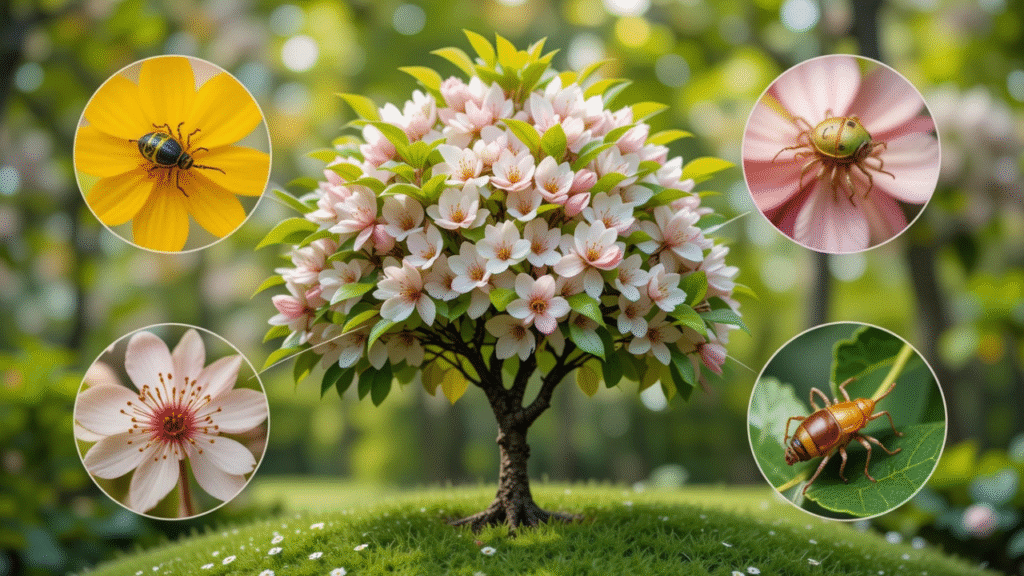
The Most Common Cherry Tree Problems and How to Solve Them: Expert Solutions for Healthy Growth
Cherry trees are not only beautiful additions to any garden but also produce delicious fruit that many gardeners cherish. However, maintaining a healthy cherry tree can be tricky as they are prone to a variety of issues. 🌳 Whether you’re a seasoned gardener or just starting out, knowing The Most Common Cherry Tree Problems and How to Solve Them is essential for ensuring your tree thrives year after year. From pests to diseases, it’s crucial to identify these problems early to keep your cherry tree in top shape. In this guide, we’ll walk you through the most common issues and provide expert solutions to help your cherry tree flourish. 🌸 Let’s dive in!
Table of Contents
ToggleCommon Cherry Tree Problems 🌳🍒
Cherry trees are beautiful additions to any garden, but they can face several challenges that affect their health and growth. Understanding The Most Common Cherry Tree Problems and How to Solve Them will help you keep your tree healthy and thriving. Here are some of the most common issues you might encounter:
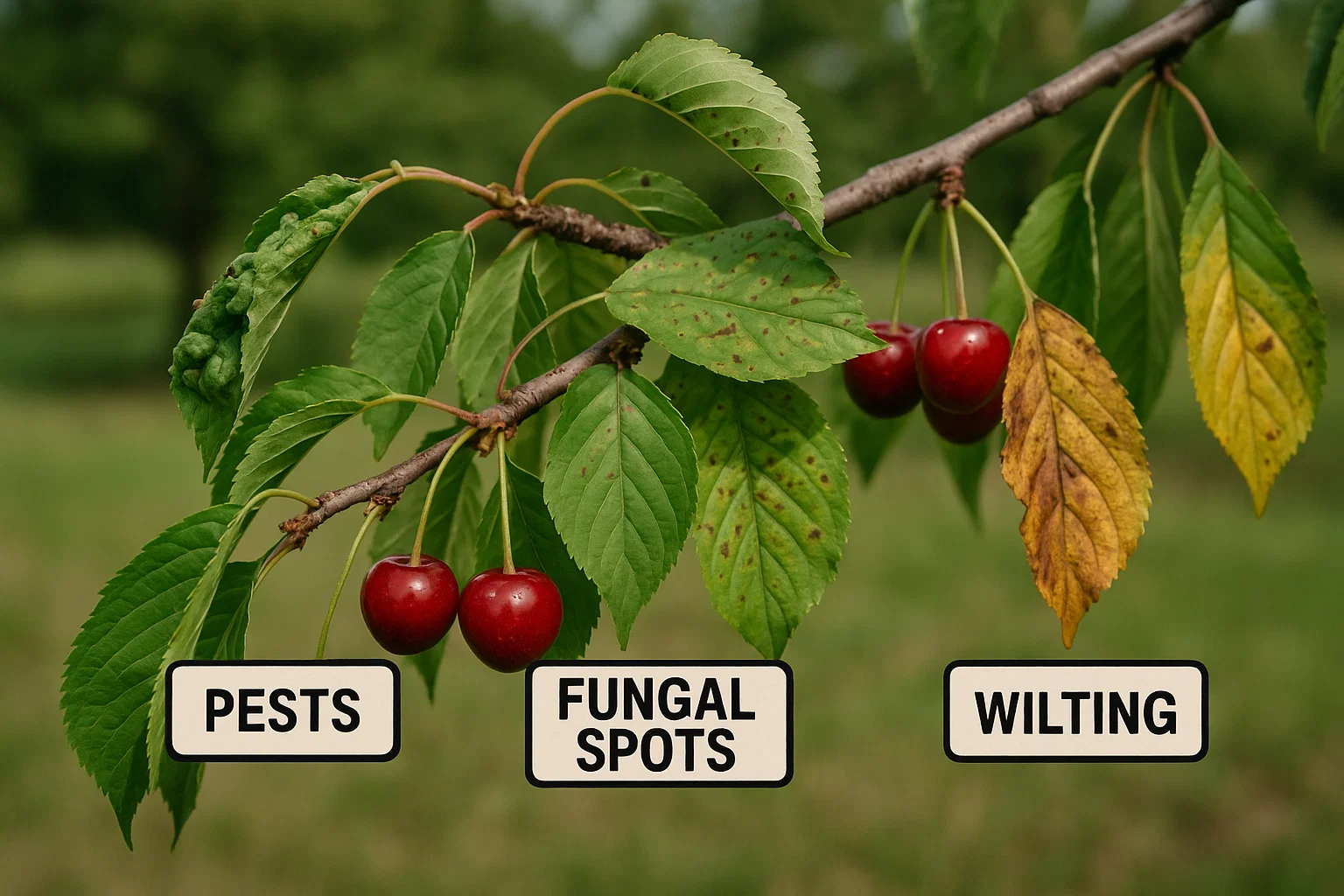
Leaf Curl and Yellowing 🍂
Leaf curl and yellowing are often early signs that your cherry tree is stressed. This could be due to fungal infections like Coryneum blight, poor watering practices, or nutrient deficiencies. Overwatering or waterlogged soil can also cause the roots to suffocate, leading to yellowing leaves.
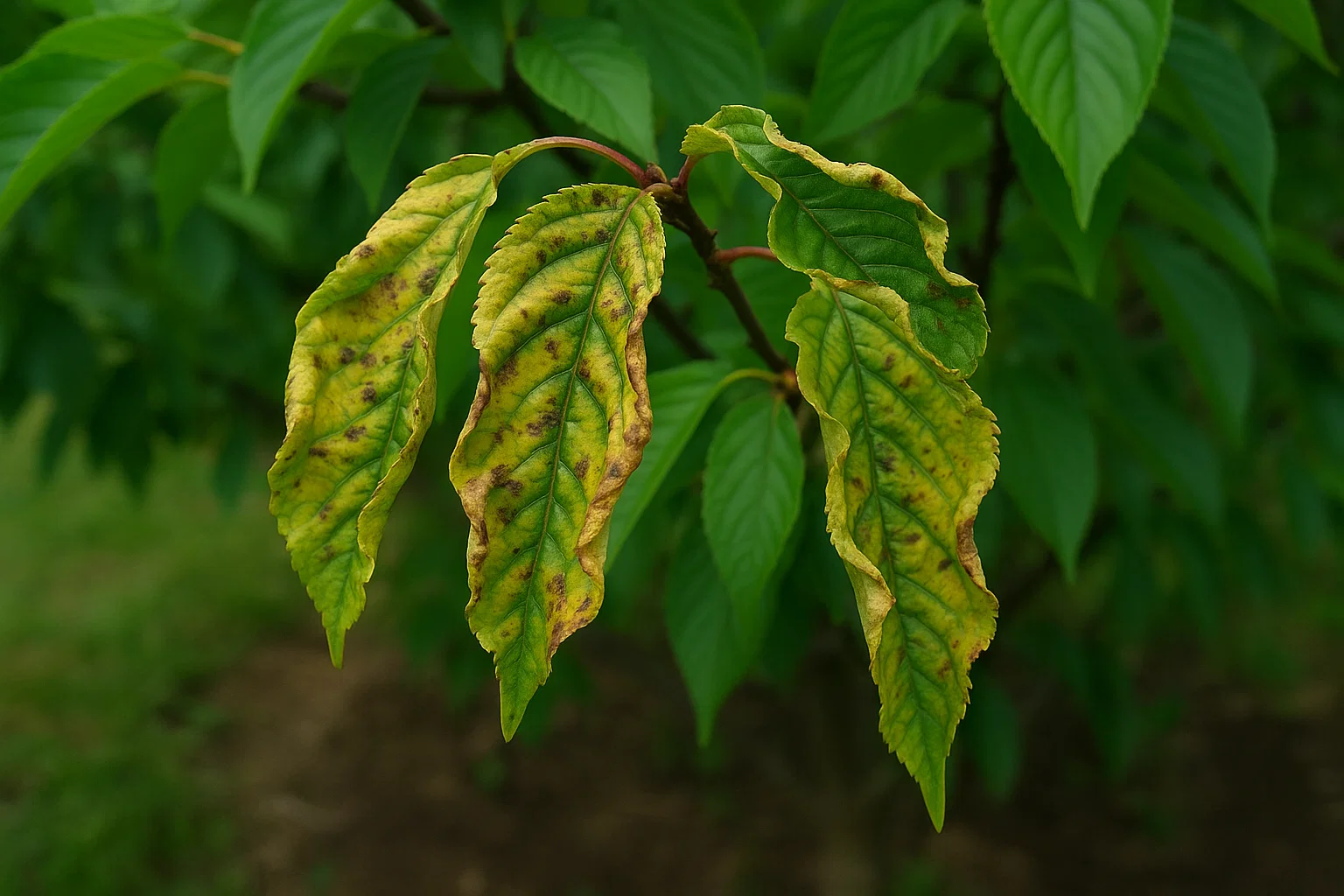
Solution: To prevent leaf curl, ensure proper watering—deep watering is preferable, and avoid watering overhead. If fungal infections are suspected, use a fungicide that targets cherry trees, and prune any affected leaves or branches to stop the spread.
Brown Spots on Leaves 🍂
Brown spots on the leaves are a common problem that usually results from bacterial or fungal infections. These spots can expand and cause the tree to lose its leaves prematurely, weakening it over time.
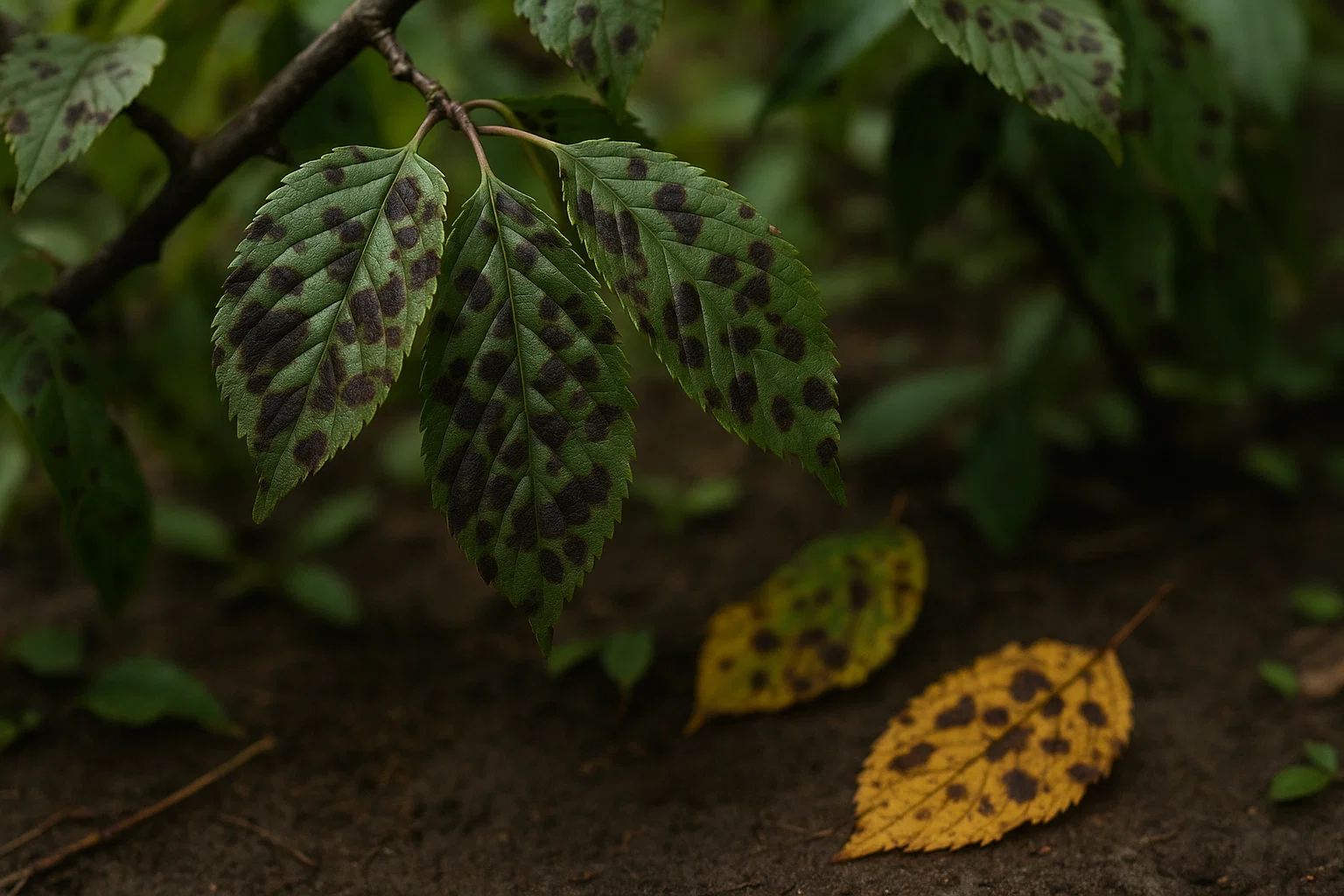
Solution: Prune affected leaves or branches immediately to reduce the spread of infection. Keep your tree’s environment clean by removing fallen leaves and debris. A copper-based fungicide or targeted fungal treatment can help control bacterial infections and prevent further damage.
Blossom Drop 🌸
It’s always disappointing when your cherry tree’s blossoms fall prematurely. Blossom drop can occur due to sudden temperature fluctuations, poor pollination, or environmental stress caused by irregular watering. Late spring frosts are another common culprit.
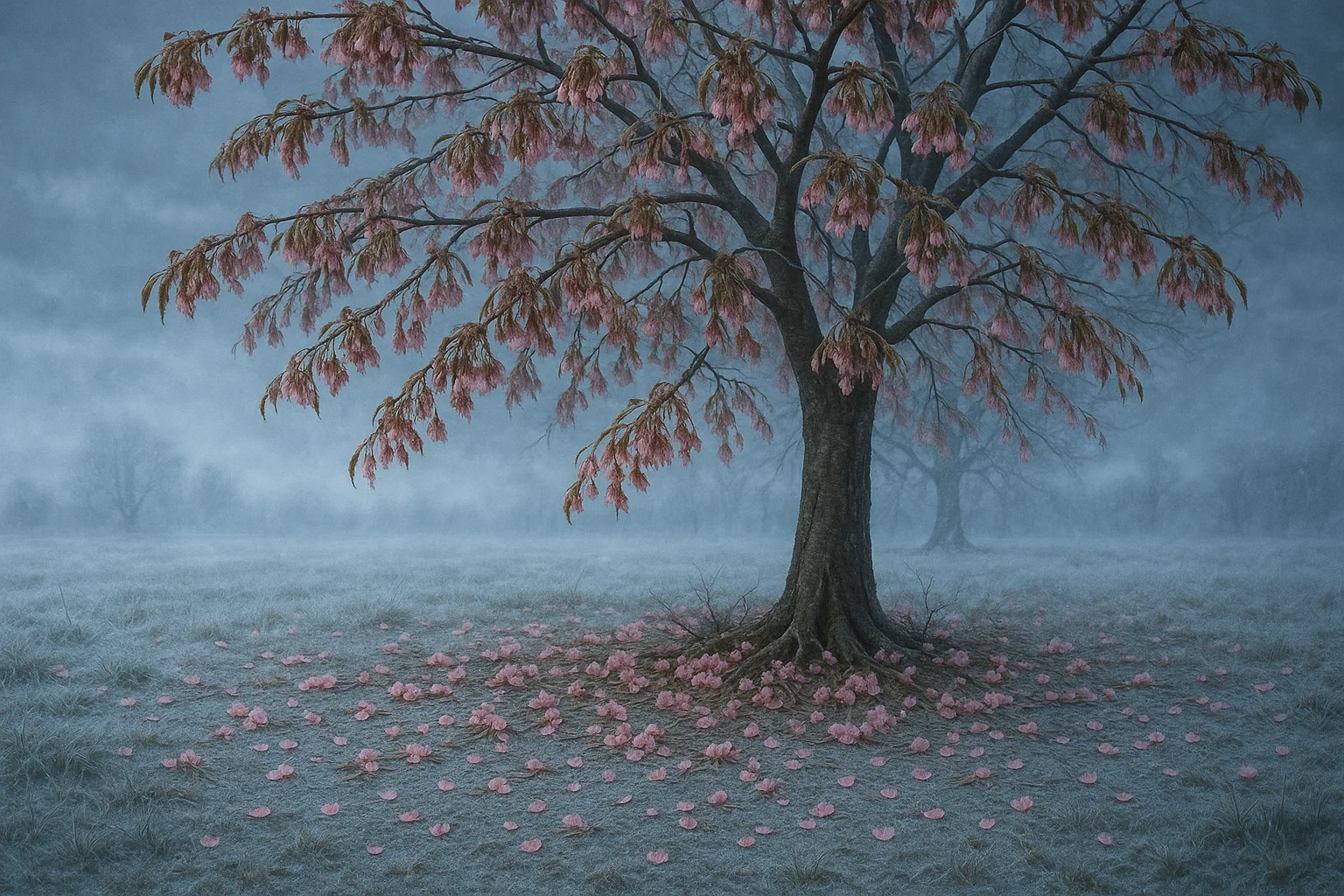
Solution: To prevent blossom drop, protect your tree from frost by covering it with a sheet during cold spells. Make sure you have adequate pollinators nearby for proper fertilization, and avoid over or underwatering during the bloom period.
Pests and Insect Infestation 🐛
Cherry trees are vulnerable to pests like aphids, caterpillars, and borers. These insects can damage the leaves, bark, and fruit of the tree, causing health problems. Aphids, in particular, are notorious for attracting ants, which further complicates pest control.
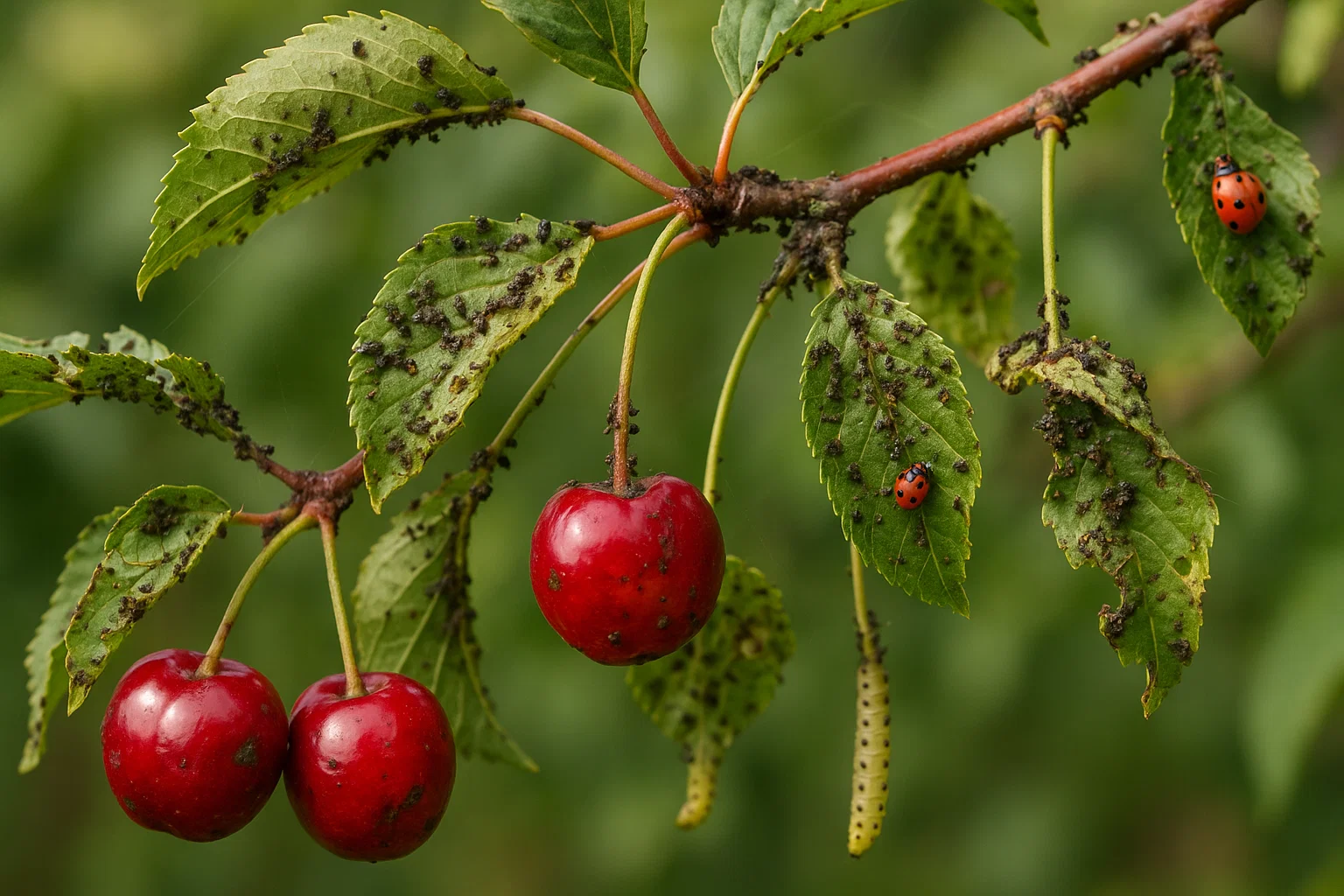
Solution: Encourage natural predators such as ladybugs to keep aphid populations in check. For a more active approach, use insecticidal soap or neem oil to treat infestations. In case of a severe pest problem, consult an expert to apply stronger treatments tailored to your tree’s specific needs.
Cracked or Splitting Bark 🌳
Cracked or splitting bark is usually caused by extreme temperature changes, physical damage, or an infection. This issue is not just cosmetic—it can expose the tree to pathogens and make it more susceptible to diseases.
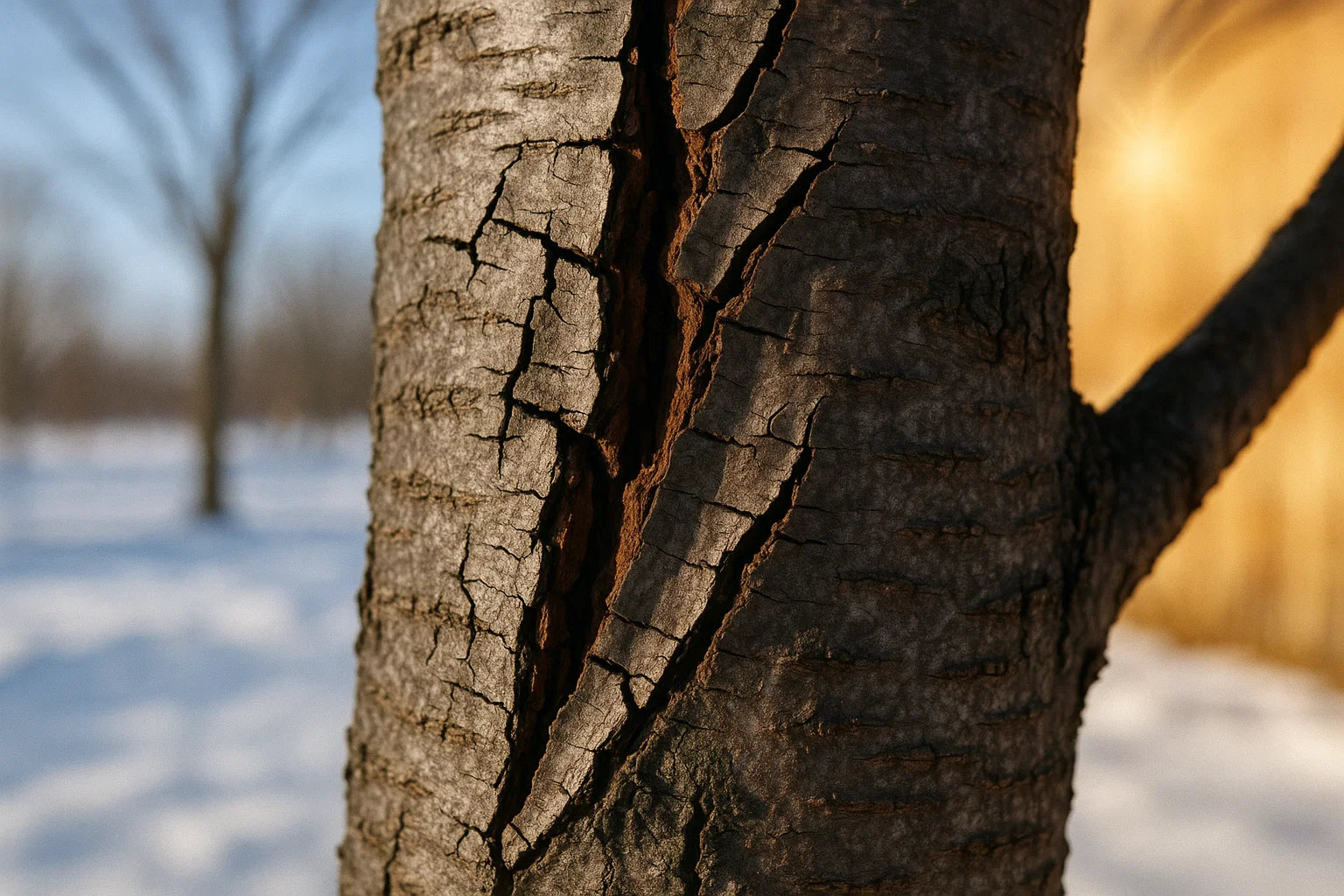
Solution: During winter, wrap the trunk of your cherry tree with tree wraps or burlap to protect it from frost damage. Avoid any activity that could harm the tree’s bark, such as improper pruning or hitting it with equipment. If the bark damage appears severe, seek professional advice to prevent infection.
By understanding these common cherry tree problems, you can take the necessary steps to prevent or treat them. Keeping an eye on your tree’s health and responding early will help ensure a vibrant, flourishing cherry tree that produces beautiful blossoms and delicious fruit for years to come. 🍒🌳
Identifying Symptoms Early
Identifying issues early is key to ensuring your cherry tree remains healthy and strong. Many common problems, when caught early, can be managed effectively before they cause significant damage. Here’s how to spot symptoms early and prevent long-term harm:
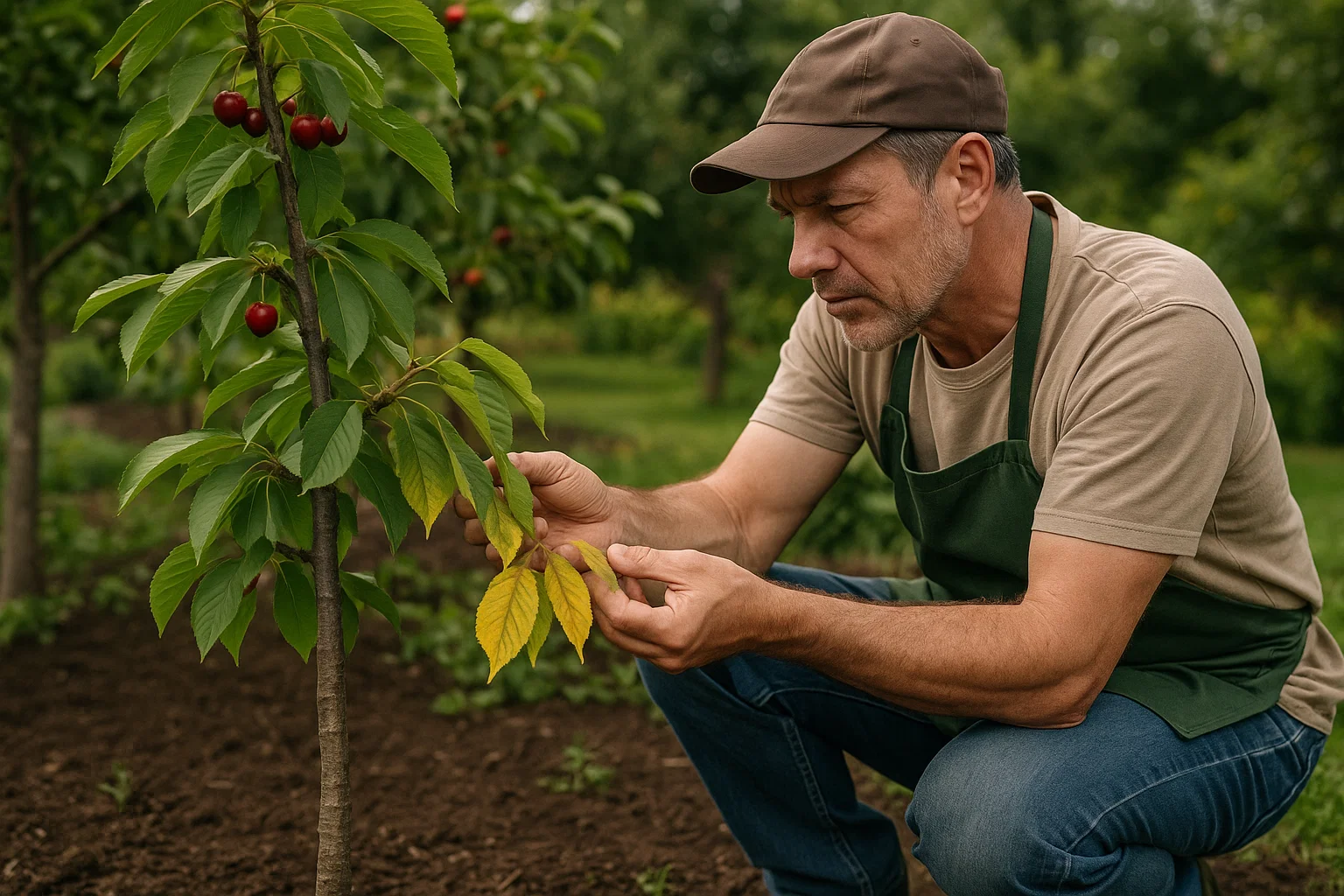
Wilting and Drooping Leaves 🌿
Wilting and drooping leaves often indicate water stress, whether from overwatering or underwatering. Cherry trees require consistent moisture, but soggy soil can lead to root rot, while drought stress causes the leaves to droop.
What to look for: Leaves that appear limp or dry at the edges are usually the first signs. The tree may also appear generally unhealthy.
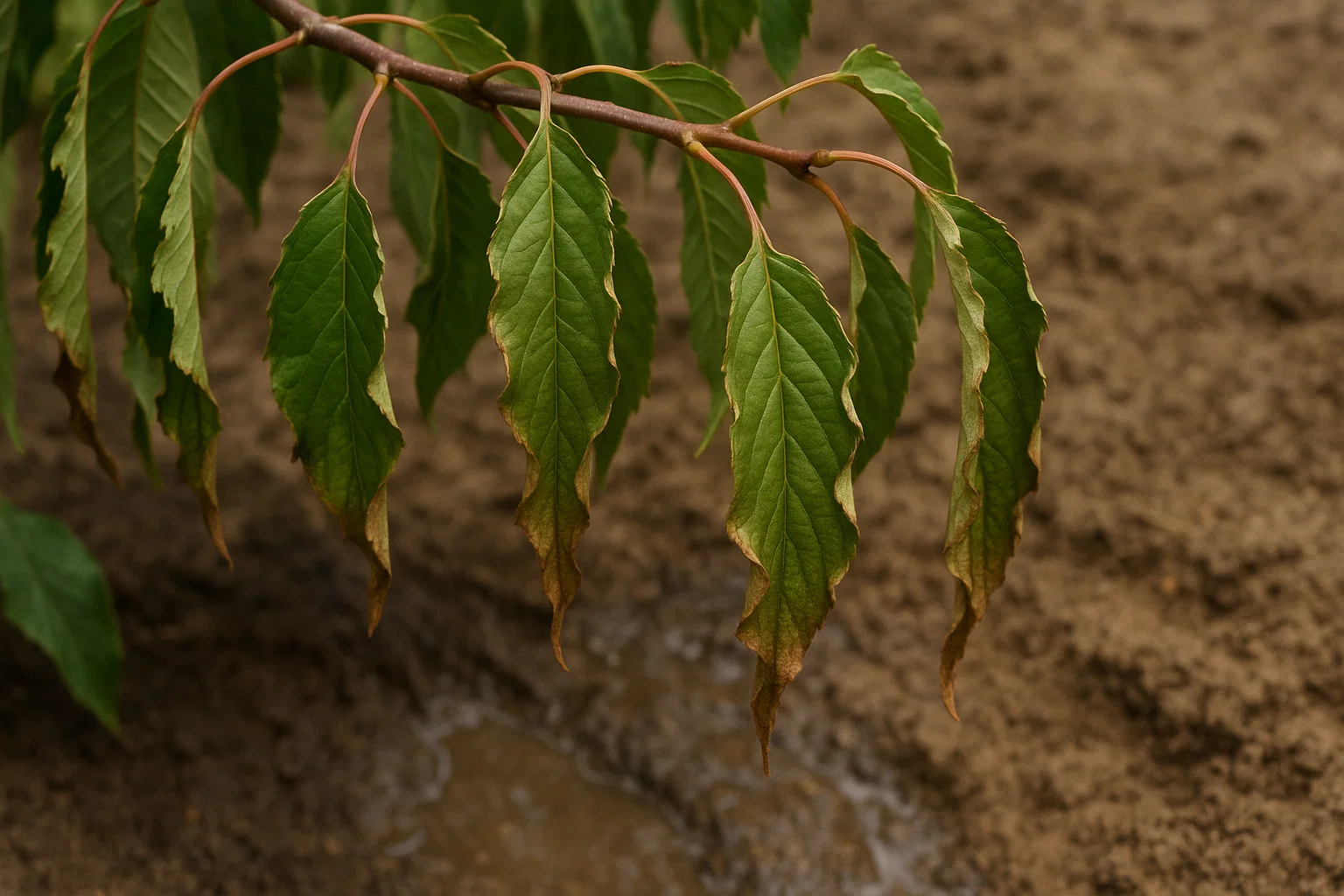
Early Action: Check the soil moisture and adjust watering habits. Ensure that the tree is getting deep, consistent watering, but not sitting in waterlogged soil. Consider adding a layer of mulch around the base to retain moisture.
Discoloration or Yellowing of Leaves 🍃
Yellowing leaves can be a sign of several issues, including nutrient deficiencies, poor soil drainage, or fungal diseases. If the leaves start to turn yellow, it could also indicate root stress or an infestation of pests like aphids.
What to look for: Yellowing starts at the tips of the leaves and may spread across the entire leaf. The presence of small insects or spots may also accompany yellowing.
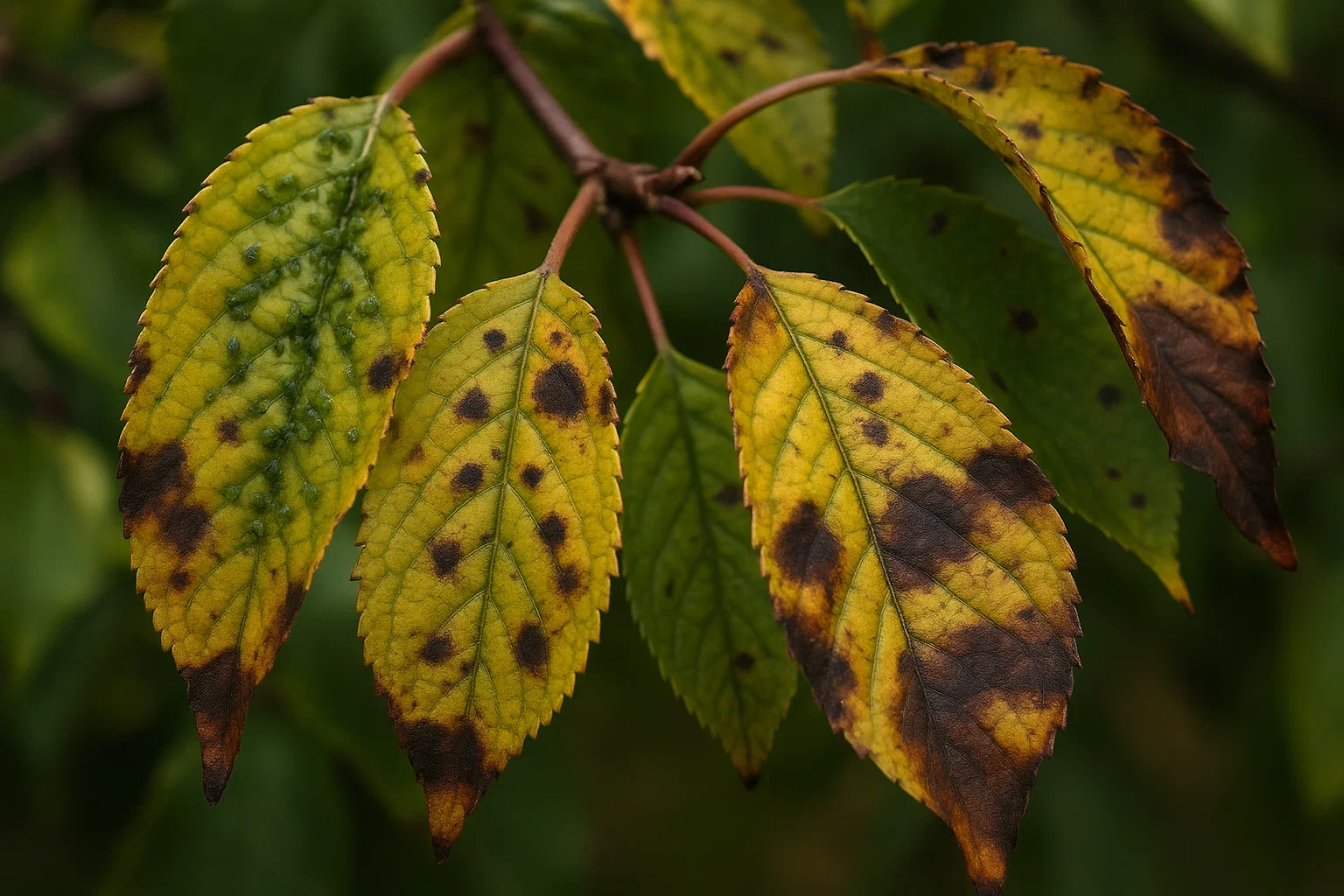
Early Action: First, ensure the tree is not overwatered. If the yellowing persists, check for pests or disease. A soil test can determine if a nutrient deficiency is present, and fertilization may be needed.
Premature Leaf Drop 🍂
Losing leaves before the usual fall time could be a sign of stress caused by diseases like Coryneum blight, or environmental factors like water imbalance or extreme weather.
What to look for: If leaves are dropping off during the growing season (especially early spring or summer), your tree may be under duress.

Early Action: Check for diseases or pests that may be causing the early leaf drop. Prune away any infected or damaged parts of the tree, and adjust watering to prevent stress. If the problem persists, consider applying a disease treatment to protect your tree.
Unusual Spots or Lesions on Leaves and Bark 🔴
Spots or lesions that appear on leaves or bark can signal fungal infections, bacterial problems, or even physical injury. These spots, especially if they appear in clusters, should not be ignored.
What to look for: Dark or discolored patches that may have a defined border. On leaves, these can be round or irregular, while on bark, they may appear as cracks or splits.

Early Action: Prune away affected parts of the tree and dispose of them carefully to avoid spreading the infection. Apply fungicides or bactericides as needed to control the spread.
Stunted Growth or Deformed Fruit 🍒
Stunted growth or fruit that doesn’t develop properly can be the result of poor soil health, pest infestations, or an underlying disease. Cherry trees should grow steadily each season and produce healthy fruit.
What to look for: Shrub-like or spindly growth instead of strong, upright branches. Deformed or underdeveloped fruit can also be a sign of trouble.

Early Action: Fertilize the soil to ensure it has the nutrients needed for healthy growth. Check for signs of pests or diseases and treat them immediately. If the tree is severely affected, consult with a professional to determine the cause.
By identifying these symptoms early, you can take timely action to prevent your cherry tree from facing serious issues. Regular monitoring and quick responses are the best way to maintain a healthy tree and ensure it thrives year after year. 🌳🍒
Best Practices for Cherry Tree Care 🌳🍒
Taking proactive care of your cherry tree is essential for its health and productivity. By following best practices for watering, pruning, and maintaining your tree, you can ensure it grows strong, produces beautiful blossoms, and yields a bountiful harvest. Here are the key practices to keep in mind:

Proper Watering Techniques 💧
Watering your cherry tree correctly is vital for its overall health. Both overwatering and underwatering can cause serious problems, from root rot to drought stress.
Best Practice:
- Deep Watering: Instead of shallow, frequent watering, aim for deep watering sessions that allow the roots to grow deeper into the soil. This helps the tree develop a strong, resilient root system.
- Check Soil Moisture: Before watering, check the soil by sticking your finger about 2-3 inches into the ground. If it feels dry, it’s time to water.
- Avoid Waterlogging: Ensure the soil drains well and doesn’t stay soggy for long periods. Mulching around the base helps retain moisture without over-saturating the soil.

Pruning and Maintenance ✂️
Pruning is essential to maintain the shape of your cherry tree, remove diseased or dead branches, and improve air circulation, which reduces the risk of fungal infections.
Best Practice:
- Prune in Late Winter or Early Spring: This is the best time to prune your cherry tree before the growing season begins. Remove any dead or diseased branches to encourage healthy growth.
- Focus on the Center: When pruning, aim to open up the center of the tree to improve airflow, which helps reduce the risk of fungal diseases.
- Remove Suckers: These are small shoots that grow from the base or roots of the tree. Removing them helps the tree focus energy on healthy growth.

Soil Health and Fertilization 🌱
Healthy soil is the foundation of a thriving cherry tree. Providing the right nutrients ensures your tree grows strong and produces high-quality fruit.
Best Practice:
- Test Soil Quality: Regularly check your soil’s pH and nutrient levels. Cherry trees prefer slightly acidic to neutral soil (pH 6.0-7.0).
- Fertilize Annually: Apply a balanced fertilizer in the spring, just as the tree begins to emerge from dormancy. Organic compost can also enrich the soil and provide slow-release nutrients.
- Avoid Over-Fertilization: Too much nitrogen can cause excessive leaf growth at the expense of fruit production, so follow the recommended dosage on your fertilizer package.

Mulching and Root Protection 🌿
Mulch is a simple yet effective way to maintain moisture in the soil, regulate temperature, and suppress weeds. It also helps protect the roots of your cherry tree.
Best Practice:
- Use Organic Mulch: Apply a 2-4 inch layer of organic mulch, such as wood chips or bark, around the base of the tree. Keep the mulch a few inches away from the trunk to prevent rot.
- Renew Mulch Regularly: Over time, mulch breaks down, so it’s important to add a fresh layer each year to maintain its effectiveness.

Monitoring for Pests and Diseases 🐜
Regular monitoring for pests and diseases will help you catch potential issues before they spread and damage your tree.
Best Practice:
- Inspect Regularly: Look for signs of pests such as aphids, caterpillars, or signs of fungal diseases like powdery mildew. Regular checks, especially in spring and summer, will help catch problems early.
- Encourage Beneficial Insects: Invite beneficial insects, like ladybugs and lacewings, into your garden to naturally control pest populations.
- Use Organic Pest Control: If pests become a problem, use organic solutions such as neem oil or insecticidal soap to avoid harming beneficial insects or the environment.

By following these best practices, you’re setting your cherry tree up for long-term success. Consistent care and attention will not only protect it from common issues but will also encourage strong growth and bountiful harvests year after year. 🌳🍒
Seasonal Care for Cherry Trees 🌳🍒
Cherry trees, like all plants, require different care at various times of the year. By adjusting your care routine to match the changing seasons, you can ensure that your cherry tree remains healthy and productive. Here’s how to care for your tree through each season:

Winter Protection ❄️
Winter can be harsh on cherry trees, especially in colder climates. Protecting your tree from freezing temperatures, frost, and harsh winds is crucial for its survival and long-term health.
Best Practice:
- Wrap the Trunk: In areas with harsh winters, wrap the trunk of your cherry tree with tree wraps or burlap to shield it from frost cracks and sunscald. This is especially important for young trees.
- Mulch for Insulation: Apply a thick layer of mulch around the base of the tree to help insulate the roots and maintain a stable soil temperature. This also prevents the roots from freezing during deep winter freezes.
- Avoid Pruning in Winter: Don’t prune your tree during winter. Pruning can stimulate new growth, which is vulnerable to frost damage.

Spring Care 🌷
Spring is the time for your cherry tree to emerge from dormancy and start its new growth cycle. During this time, focus on giving your tree the energy it needs to thrive through the warmer months.
Best Practice:
- Fertilize: Apply a balanced, slow-release fertilizer early in the spring to provide your cherry tree with essential nutrients. This encourages strong growth and healthy blooms.
- Watering: As the weather warms up, ensure that your tree receives consistent moisture. Cherry trees need deep watering to establish strong roots, especially after winter.
- Monitor for Pests: Spring is when many pests become active. Regularly check your tree for aphids, caterpillars, and other pests that can damage new growth.

Summer Care 🌞
Summer is the growing season for cherry trees, and it’s crucial to provide proper care during this time to promote healthy development and fruit production.
Best Practice:
- Consistent Watering: Cherry trees need regular watering during the hot summer months. Water deeply to ensure the tree’s roots remain hydrated but be mindful not to overwater, as this can cause root rot.
- Prune Dead or Diseased Branches: If you haven’t already pruned in the spring, summer is a good time to remove any dead or damaged branches. Be sure to use clean, sharp tools to avoid infecting the tree.
- Protect Against Heat Stress: During extreme heat waves, consider providing some shade for the tree’s roots by adding additional mulch or using a shade cloth. This will help keep the roots cool and reduce stress on the tree.

Fall Care 🍂
As the growing season ends, fall is a time for your cherry tree to prepare for winter. This is a great opportunity to give it a final boost before the cold months ahead.
Best Practice:
- Water Deeply: Before the tree goes into dormancy, give it a deep watering to ensure the roots are well-hydrated and able to withstand the winter months.
- Remove Fallen Leaves: Clean up fallen leaves around the base of the tree to prevent the spread of diseases and pests that may overwinter in the debris.
- Fertilize if Needed: If your tree hasn’t been fertilized yet or if it shows signs of nutrient deficiencies, consider applying a mild, balanced fertilizer. Avoid over-fertilizing at this time to prevent new, vulnerable growth.

By adjusting your cherry tree care routine for each season, you’ll help ensure that your tree stays strong and healthy throughout the year. Seasonal care is about anticipating your tree’s needs and responding to environmental changes to give it the best chance to thrive. 🌳🍒
Troubleshooting and Expert Tips 🌳🍒
Even with the best care, your cherry tree may occasionally face issues that require troubleshooting. Whether it’s an unexpected pest outbreak or a sudden decline in health, knowing how to address these problems quickly can make a world of difference. Here are some expert tips and solutions for dealing with common issues:
Persistent Problems with Pests 🐞
Pests can be persistent and challenging to control, but with the right approach, you can manage them effectively without harming the tree or the environment.
Expert Tip:
- Encourage Beneficial Insects: Instead of relying solely on chemical insecticides, consider introducing natural predators like ladybugs, lacewings, and predatory beetles. These insects feed on harmful pests such as aphids, making them an excellent organic pest control option.
- Neem Oil and Insecticidal Soap: For more severe infestations, use organic treatments like neem oil or insecticidal soap. These are gentle on the tree but effective against a wide range of pests, including aphids, mites, and whiteflies.
- Regular Inspection: Conduct regular checks on the underside of leaves and branches where pests often hide. Early detection is crucial to preventing widespread damage.

Disease Management 🦠
Cherry trees can be susceptible to a variety of fungal and bacterial diseases. Early intervention is essential to prevent these diseases from spreading and causing long-term damage.
Expert Tip:
- Proper Pruning and Clean Tools: Always prune dead or diseased branches promptly, and ensure that your tools are clean and disinfected to avoid transferring disease from one part of the tree to another.
- Fungicides and Bactericides: If you notice symptoms of fungal diseases like powdery mildew or cherry leaf spot, consider applying a fungicide. For bacterial infections like Coryneum blight, a copper-based bactericide can be effective.
- Good Air Circulation: Prevent the spread of fungal diseases by ensuring your tree has proper airflow. This can be achieved by pruning to remove overcrowded branches and promoting healthy growth.
Yellowing Leaves with No Apparent Cause 🍃
If your cherry tree’s leaves are turning yellow but you can’t pinpoint the cause, it could be due to several factors, including nutrient deficiencies, poor soil drainage, or even environmental stress.
Expert Tip:
- Soil Testing: Perform a soil test to check for nutrient imbalances. A deficiency in nitrogen, iron, or other essential nutrients can lead to yellowing leaves. Based on the results, amend the soil with the necessary fertilizers.
- Avoid Overwatering: Yellowing leaves can also be a sign of root rot caused by overwatering or poor soil drainage. Make sure the tree’s roots are not sitting in waterlogged soil, and consider improving drainage around the tree’s root zone.
- Check for Competing Roots: If the tree is planted near larger plants or structures, their roots may be competing for water and nutrients. Consider relocating the tree or removing any nearby invasive roots.
Slow or Stunted Growth 🌱
If your cherry tree is growing slowly or has stopped growing altogether, there may be underlying issues related to soil health, watering, or even root damage.
Expert Tip:
- Fertilization: Ensure that your tree is receiving adequate nutrients, particularly nitrogen, which is crucial for healthy growth. Apply a balanced fertilizer designed for fruit trees to encourage growth.
- Proper Watering Practices: Over or underwatering can stunt growth. Ensure your cherry tree is watered deeply but not too frequently. The soil should remain moist but not soggy.
- Check for Root Compaction: In compacted soil, roots may struggle to grow. Consider aerating the soil around your tree to improve root penetration and water absorption.
When to Seek Professional Help 🧑🌾
While most issues can be managed with proper care, there are times when it’s best to call in a professional. If your tree is facing severe pest infestations, widespread disease, or structural damage, a certified arborist can provide expert advice and treatment.
Expert Tip:
- Certified Arborist: If you’re unsure about diagnosing a problem or if the issue persists despite your efforts, hiring a certified arborist can be a great investment. They can assess the tree’s overall health, recommend appropriate treatments, and help with pruning or disease control.
By following these troubleshooting tips and expert solutions, you can quickly address most problems that may arise with your cherry tree. Regular care, early detection, and quick action are the keys to keeping your tree healthy and ensuring it thrives for years to come. 🌳🍒
Final Thoughts 🌳✨
Caring for a cherry tree may seem challenging at times, but with the right knowledge and consistent effort, you can enjoy a healthy, thriving tree year after year. By understanding The Most Common Cherry Tree Problems and How to Solve Them, identifying symptoms early, and implementing the best practices for care, you’ll be well on your way to fostering a tree that produces beautiful blossoms and delicious fruit. 🌸🍒

Remember, regular maintenance is key—pruning, watering, and pest control are essential tasks that will ensure the long-term health of your cherry tree. Be proactive and patient, as your efforts will reward you with a stunning tree that will be the centerpiece of your garden.
If you ever find yourself unsure or facing persistent problems, don’t hesitate to seek professional help. A little expert guidance can make a big difference in keeping your cherry tree at its best.
Happy gardening, and may your cherry tree flourish! 🌳✨
Frequently Asked Questions (FAQs)
What are the most common cherry tree problems?
The most common issues include pests, diseases, poor soil conditions, transplant shock, and environmental stressors such as drought or extreme temperatures.
How can I prevent cherry tree pests?
Regularly inspect your tree for pests like aphids, spider mites, and cherry fruit flies. Use organic insecticidal soap or neem oil for control and encourage natural predators like ladybugs.
Why are the leaves on my cherry tree turning yellow?
Yellowing leaves can be caused by nutrient deficiencies, overwatering, or a fungal disease. Ensure proper watering and check soil for any pH imbalances or nutrient shortages.
How do I treat cherry tree diseases?
Diseases like powdery mildew and cherry leaf spot can be controlled with fungicides. Prune affected branches, and ensure your tree gets enough sunlight and airflow to reduce fungal growth.
What causes cherry tree bark to crack?
Cracked bark is often a result of winter damage or extreme temperature fluctuations. Wrap the tree’s trunk with protective burlap during the colder months to prevent this issue.
How can I fix cherry tree transplant shock?
To combat transplant shock, water the tree deeply, provide shade, and avoid fertilizing too soon. Be patient, as it may take time for the tree to re-establish its roots.
When should I prune my cherry tree?
Prune your cherry tree during its dormant season (late winter or early spring) to remove dead or diseased branches and encourage healthy growth in the coming season.
What soil conditions are best for cherry trees?
Cherry trees prefer well-drained, slightly acidic soil (pH 6.0-6.5). Regularly test soil conditions and amend them with organic matter to improve drainage and fertility.
